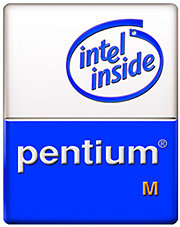|
Stealey (microprocessor)
Stealey is the codename for a low-power x86 architecture microprocessor based on a ''Dothan'' core derived from the Intel Pentium M, built on a 90 nm process with 512 KB L2 cache and 400 MT/s front side bus (FSB). It was branded as Intel A100 and Intel A110 and appeared as part of the McCaslin platform. They were replaced in 2008 by the Menlow platform, including the 45 nm Silverthorne CPU and Poulsbo SCH. The A110 runs at 800 MHz, the A100 at 600 MHz, and both have a TDP of 3 watts, and a power consumption in the lowest power state of only 0.4 watts. The A100 and A110 processors are part of the Intel Ultra Mobile Platform 2007 and were designed to be used in MIDs, UMPCs and Ultralight laptops. See also * Pentium M (microarchitecture) * Mobile Internet device (MID) * Intel Atom - Intel's successor for this market * AMD Geode Geode was a series of x86-compatible system-on-a-chip microprocessors and I/O companions produced by AMD, targeted at the embedded co ... [...More Info...] [...Related Items...] OR: [Wikipedia] [Google] [Baidu] |
Pentium M
The Pentium M is a family of mobile 32-bit single-core x86 microprocessors (with the modified Intel P6 microarchitecture) introduced in March 2003 and forming a part of the Intel Carmel notebook platform under the then new Centrino brand. The ''Pentium M'' processors had a maximum thermal design power (TDP) of 5–27 W depending on the model, and were intended for use in laptops (thus the "M" suffix standing for ''mobile''). They evolved from the core of the last Pentium III–branded CPU by adding the front-side bus (FSB) interface of Pentium 4, an improved instruction decoding and issuing front end, improved branch prediction, SSE2 support, and a much larger cache. The first Pentium M–branded CPU, code-named Banias, was followed by Dothan. The Pentium M line was removed from the official price lists in July 2009, when the Pentium M-branded processors were succeeded by the Core-branded dual-core mobile Yonah CPU with a modified microarchitecture. It replaced the Mobile Penti ... [...More Info...] [...Related Items...] OR: [Wikipedia] [Google] [Baidu] |
Poulsbo (chipset)
System Controller Hub (SCH) is a family of Intel microchips employed in chipsets for low-power Atom-based platforms. Its architecture is consistent with the Intel Hub Architecture but combines the traditional northbridge and southbridge functions into a single microchip. Poulsbo Poulsbo is the codename of the first SCH and plays a key role in Intel's second-generation Menlow UMPC and MID platform chipset for Atom Silverthorne microprocessors. The graphics core is called GMA 500 and unlike most graphics cores used by Intel was developed by Imagination Technologies. Intel licensed the PowerVR SGX 535 as a graphics core and the PowerVR VXD370 for H.264/MPEG-4 AVC playback. The video core is able to process 720p as well as 1080i resolutions. This has the following variations: SCH UL11LSCH US15LSCH US15WSCH US15WPSCH US15WPTSCH US15X GMA 500 Linux support Although several netbooks using the Poulsbo chipset are shipped with some distribution of Linux (notably the Sony Vaio P ... [...More Info...] [...Related Items...] OR: [Wikipedia] [Google] [Baidu] |
Pentium M (microarchitecture)
The P6 microarchitecture is the sixth-generation Intel x86 microarchitecture, implemented by the Pentium Pro microprocessor that was introduced in November 1995. It is frequently referred to as i686. It was succeeded by the NetBurst microarchitecture in 2000, but eventually revived in the Pentium M line of microprocessors. The successor to the Pentium M variant of the P6 microarchitecture is the Core microarchitecture which in turn is also derived from P6. P6 was used within Intel's mainstream offerings from the Pentium Pro to Pentium III, and was widely known for low power consumption, excellent integer performance, and relatively high instructions per cycle (IPC). The P6 line of processing cores was succeeded by the NetBurst (P68) architecture which appeared with the introduction of Pentium 4. The P6 core was the sixth generation Intel microprocessor in the x86 line. The first implementation of the P6 core was the Pentium Pro CPU in 1995, the immediate successor to the ori ... [...More Info...] [...Related Items...] OR: [Wikipedia] [Google] [Baidu] |
